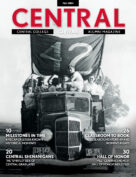 As an architect, Ann Munson often works within fixed parameters. They may be imposed by a client or a building site, or they may simply be imposed by physics and what is possible. But she doesn’t believe those parameters are a damper on creativity.
As an architect, Ann Munson often works within fixed parameters. They may be imposed by a client or a building site, or they may simply be imposed by physics and what is possible. But she doesn’t believe those parameters are a damper on creativity.
“The more rigid frameworks that some people might see as limitations or restraints, those actually give us a lot of opportunity to be creative in the way we respond to them,” she says. “They’re more helpful than limiting.”
Munson’s successful career in architecture wasn’t something she planned on while at Central. She majored in English and Spanish and participated in three international programs while a student, including a trip to the Yucatan for a course called Politics of World Hunger taught by Jim and Louise Zaffiro. Munson loved the interdisciplinary nature of the trip, and the fact that “you have a collection of people from all different areas going to Mexico to study world hunger.”
This commitment to interdisciplinary work could be the hallmark of her pursuits through the years. After Central, she headed to Emory University and a Ph.D. program in English, thinking she would eventually teach. But after two years she felt the need to do something different, something more “hands-on.” She still loved teaching, and she took a job in admission with Central to stay involved with higher education and to consider what she wanted to pursue.
During this time she met the dean of architecture for Washington University in St. Louis who was speaking at Central, and hearing her speak “set off a lightbulb,” Munson says. She discovered there were graduate programs in architecture designed for people with backgrounds in other areas, and she graduated from Iowa State University in 2000 with a master’s in architecture. She then taught in the ISU College of Design for seven years, before taking a job with substance architecture in Des Moines.
Bringing together information from various disciplines is something Munson sees as valuable for creativity. She views the liberal arts environment as a place where that sort of learning is more accessible. “The way students can work between disciplines and programs is something that can be easily taken for granted,” she says.
How would you describe your job in one sentence?
I produce and coordinate technical documents and project delivery process that translate design concepts into built environments.
What aspect of your job gives you the most satisfaction?
I love translating complex ideas into forms that are easily accessible and understood by non-architects. I also enjoy working through issues to develop discernible and consistent logics, expressed through physical space and materiality.
How is creativity important in being an architect?
A colleague of mine has said while most of the world might ask “Why?” it is the architect’s job to ask “Why not?” In the face of multiple necessary constraints, architects imagine what might be possible, using the constraints as generative tools rather than limiting requirements.












To encourage serious, intellectual discourse on Civitas, please include your first and last name when commenting. Anonymous comments will be removed.
Walter Cannon
|
5:42 pm on May 28, 2016
So nice to see you on the cover of Civitas Ann. You were always a bright spark of intellect and creativity…why not Indeed?